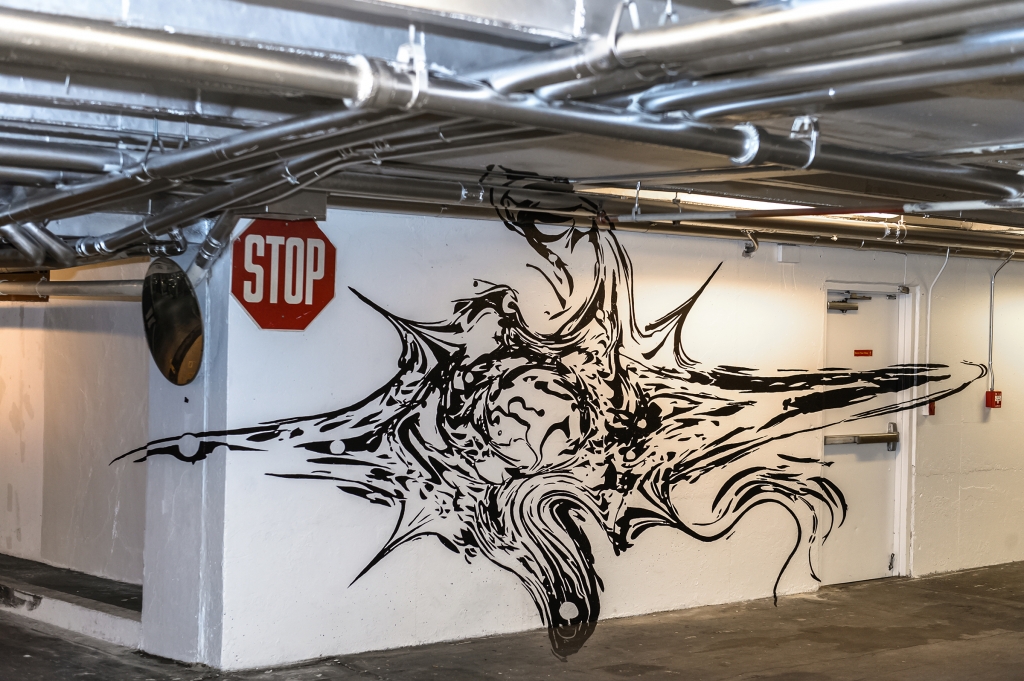Artist James Weingrod has been awed by the idea of the universe ever since his insomniac childhood. His father, who loved space, would read him science books when he couldn’t sleep, but the puzzle of an infinite outer space bred more intrigue than it did rest. His curiosity stuck with him as he went off to Brown University, then Hunter College, and grew into an artist; he’d be the first to tell you his work is more filled with questions than it is answers.
Artist James Weingrod has been awed by the idea of the universe ever since his insomniac childhood. His father, who loved space, would read him science books when he couldn’t sleep, but the puzzle of an infinite outer space bred more intrigue than it did rest. His curiosity stuck with him as he went off to Brown University, then Hunter College, and grew into an artist; he’d be the first to tell you his work is more filled with questions than it is answers.
“A lot of my work focuses on the universe, but also on how people try to think about the universe or understand the universe – and they can’t,” he says.
The same curiosity has led Weingrod to experiment with a number of different processes, from using found objects as canvas to changing the chemistry of his paints to employing screen and digital printing. Many of his pieces combine a number of techniques; “the universe is this unknown, infinite thing,” he says, “so it seems like trying to represent that in as many different mediums as you can would be appropriate.”
 One such installation was set in Miami when Weingrod was a resident at the National YoungArts Foundation. Entitled “Sunk,” the piece took over a service window in the YoungArts headquarters. Weingrod screen printed onto Plexiglas so that the only transparent areas were tiny stars; LEDs on the windowsill shined through the pattern and cast light and shadows throughout the work.
One such installation was set in Miami when Weingrod was a resident at the National YoungArts Foundation. Entitled “Sunk,” the piece took over a service window in the YoungArts headquarters. Weingrod screen printed onto Plexiglas so that the only transparent areas were tiny stars; LEDs on the windowsill shined through the pattern and cast light and shadows throughout the work.
Advertisement
And it’s clear the artist loves to toy with irony: “Just the idea of trying to make something that’s a representation of something that’s infinite and then stick it inside of this finite space always tickles me.” Another piece, “The Clockwork Universe,” ties lights, paint, and mirrors together within a grandfather clock, creating the illusion that an infinite number of pendulums are swinging back and forth inside.
One of his favorite techniques is to take the raw ingredients used to make paint and create dripped patterns on a horizontal panel of wood or aluminum – and no, this isn’t something a six-year-old would create in an after-school art program. Weingrod says he’s been studying the chemistry and physics of paint for years to understand how gravity and surface tension will affect the different chemical combinations.
“It’s really kind of eerie,” he says. “The way that liquid dynamics work and the way that the pigments work in relation to the other chemicals looks very much like a lot of stuff you see in photos of space.”
Many of these works become multimedia puzzles, as well: He’ll create a painting, then photograph it and print the photograph. From there he might cut out pieces, create a collage, and pour a new mixture of paint over that. “It might just be a painting in the end,” he says, “but the painting and reproducing the painting, cutting it out, changing it, repouring over that, photographing that again, putting that in the computer, printing – it can almost go on forever, sort of like the universe.”
One of Weingrod’s more recent, larger undertakings, “Infinite Space,” was a takeover of Brown University’s Granoff Center. He started out with his usual, multi-faceted process: Drawings evolved into prints via Brown’s Epson Stylus Pro 9900 printer; pouring water onto those prints led to more organic forms. The scan-and-print cycle would continue until the image was ready to be vectorized. Then, he’d project it into the lobby and discern where it would fit in the space – and then redraw it.

Advertisement
But the painstaking work had barely begun; Weingrod hired 12 assistants to help with fundraising – “artists should get paid for their work,” he insists – promotion, and executing the 5000-square-foot installation. The team covered the entire space in black Orafol adhesive vinyl and white protective masking film, traced the projected images, and cut and peeled away the negative areas by hand. This part of the meticulous process alone took roughly eight weeks.
And an artist’s work is never done. The vinyl hung at Granoff Center from October 2015 until June 2016; along the way, Weingrod created digital prints featuring photographs of the installation. The prints ranged from signed posters to catalogs promised to those who donated to fundraising efforts.
Weingrod also found a way to bring intrigue to the project’s destruction with a community “peeling party”: “Our collective removal of the work will essentially follow the theoretical model of a wormhole, disappearing from one place only to reappear in another form and place in space and time,” he said in an email blast.
What’s next for the limitless imagination of his mind? Many of the artist’s future plans center on using technology to create further depth, and conversely, simplicity, in his work. After using a Roland vinyl cutter to create a preview of the Granoff Center installation, he began imagining other uses for the machine, such as cut-out stars much like the ones he screen printed in Miami. He cites plans to experiment with an inkjet printer to see whether it can print with paint. And, always drawn to chemistry, Weingrod says he’s had “very interesting results” mixing screen-printing base with pure pigments.
Looking back on the years before he called himself an artist, Weingrod says he never thought one could make a career out of art. But his role model, Frank Stella, a successful artist and well-known printmaker changed that; now, Weingrod says “we’re all kind of artists. Whether you’re working in a factory putting together cars or … whether you’re building houses, people just make. Part of the human condition is that we want to make tools; we want to make things; we want to use our hands.”
Read more from our August/September 2016 issue.
Advertisement


 Case Studies2 months ago
Case Studies2 months ago
 Art, Ad, or Alchemy2 months ago
Art, Ad, or Alchemy2 months ago
 Andy MacDougall2 months ago
Andy MacDougall2 months ago
 Columns3 weeks ago
Columns3 weeks ago
 Editor's Note3 weeks ago
Editor's Note3 weeks ago
 Marshall Atkinson3 weeks ago
Marshall Atkinson3 weeks ago
 Thomas Trimingham2 months ago
Thomas Trimingham2 months ago
 Case Studies3 weeks ago
Case Studies3 weeks ago
 One such installation was set in Miami when Weingrod was a resident at the National YoungArts Foundation. Entitled “Sunk,” the piece took over a service window in the YoungArts headquarters. Weingrod screen printed onto Plexiglas so that the only transparent areas were tiny stars; LEDs on the windowsill shined through the pattern and cast light and shadows throughout the work.
One such installation was set in Miami when Weingrod was a resident at the National YoungArts Foundation. Entitled “Sunk,” the piece took over a service window in the YoungArts headquarters. Weingrod screen printed onto Plexiglas so that the only transparent areas were tiny stars; LEDs on the windowsill shined through the pattern and cast light and shadows throughout the work.
















